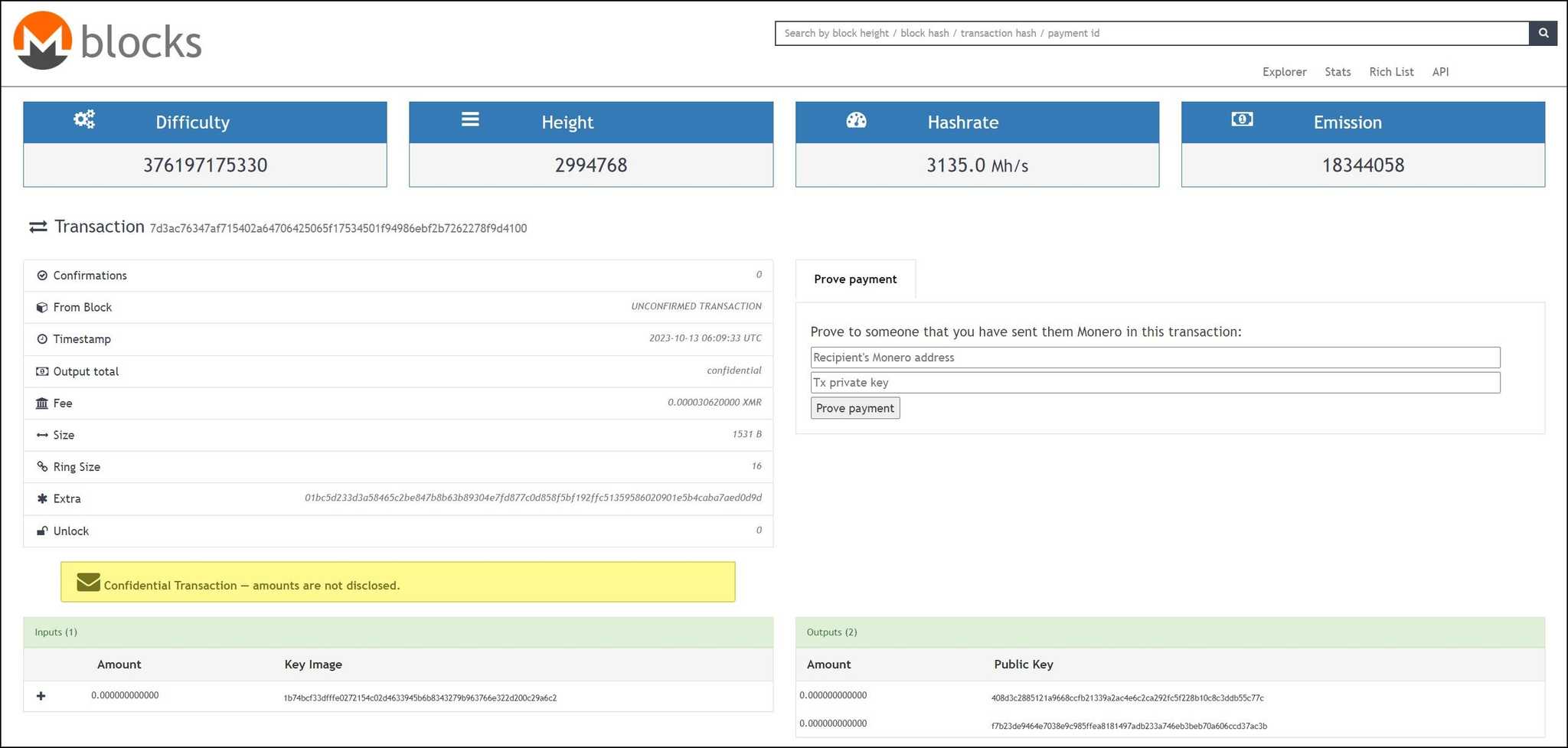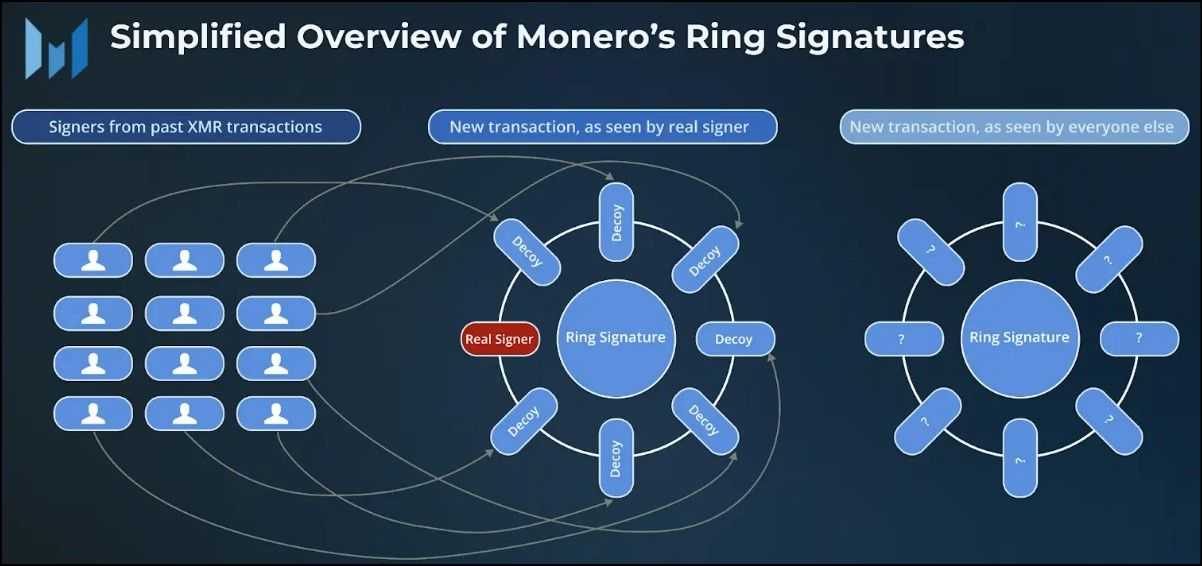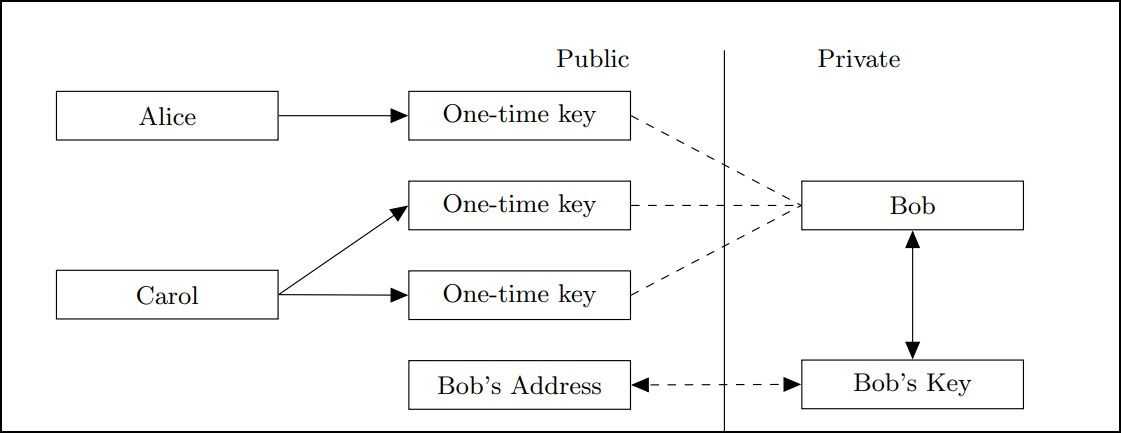In blockchain design, anonymity and pseudonymity are analogous principles. The Bitcoin network is a pseudonymous blockchain, meaning the transactions are recorded in an open ledger that anyone can view, but personal information about the sender and receiver is not readily transparent. However, advancements in blockchain analysis have led to Bitcoin transactions being easily traceable, with blockchain analytics companies being able to figure out which addresses belong to which people, making Bitcoin Pseudonymous, but not anonymous.
A couple of prominent techniques involve revealing the real identities of Bitcoin users by connecting the dots between publicly available transaction metadata such as addresses, timestamps and amounts with the user’s IP address. Even when they use separate addresses for every transaction, one can backtrack the transfers to their root with metadata.
In light of such loopholes, the Monero network was born as a fork of a project known as “Bytecoin” in April 2014. Monero is one of the earliest blockchains to advocate complete anonymity, which entailed addressing the anonymity weaknesses plaguing networks like Bitcoin.
This article is a primer on understanding Monero’s Anonymity and learning how to use it efficiently. If you are curious about the nuances between Monero and Bitcoin, we explore those granular differences in an article in our Bitcoin vs Monero. I suggest checking out Coin Bureau’s learner on the Monero Protocol to refresh your concepts. However, here’s a TLDR of Monero:
What is Monero?
Monero is the first privacy-focused and censorship-resistant blockchain. Every Monero blockchain user and their transactions are anonymous by default. Two essential characteristics are the cornerstone of the Monero Protocol:
- Untraceability – All possible senders are equiprobable for each incoming transaction.
- Unlinkability – It is impossible to prove any two transactions were sent to the same person.
Despite such anonymity, anyone can cryptographically verify the correct execution of a transaction on the Monero blockchain with transaction proofs recorded in the public database.

Key features of the Monero blockchain include:
Privacy
Monero is the strongest proponent of privacy. The network anonymizes transaction amounts and obfuscates sender and receiver identities with cryptographic techniques like stealth addresses and ring signatures.
Security
Monero is a permissionless and decentralized Proof-of-Work protocol. Therefore, it benefits from the security properties of similar networks, like no central authority and no control over transaction data or user’s personal information.
Equitable Mining
Monero uses a unique POW mining algorithm called RandomX that is ASIC-resistant. Here is what it means –
The Bitcoin network follows a “one CPU – one vote” policy in its mining protocol. This logic proved sufficiently equitable in the early days of the network when the hashing power required to run the network was shallow and affordable. However, as the network grew in adoption, specialized hardware called ASICs emerged. ASICs are custom-built for mining and solving hash functions efficiently. Bitcoin mining has since become a race to acquire the most potent ASICs, where every CPU is undoubtedly not equitable, leading to the centralization of mining activity in pools and places with cheap electricity.
Monero ASIC-Resistant Mining
The RandomX mining algorithm constantly updates its code to maintain ASIC resistance. RandomX deploys RAM-heavy techniques to make mining memory intensive. Adding RAM to ASICs is expensive and complex. The memory-hard nature of RandomX outweighs the benefits of deploying expensive ASICs over conventional CPUs, democratizing its consensus process.
Adaptive Block Size
Monero’s adaptive block size adjusts based on transaction volume, ensuring that mining remains efficient and the network can scale with demand. This feature ensures that transactions are processed on time, even during high demand, benefiting all network participants.
IP Address Privacy (Under Development)
Kovri is a decentralized anonymity technology designed to help hide the IP addresses of participants of the Monero blockchain. IP addresses can reveal the user’s location and real-world identity. Therefore, Kovri enhances the privacy of Monero. Kovri hides IP by encrypting user internet traffic.
Another subtle design aspect of Monero is its 2-minute transaction confirmation time, which takes about ten minutes to achieve finality. The Monero development team frequently forks the network to add new privacy features. Let’s discuss how Monero works:
How Monero Works
Monero is a peer-to-peer digital cash network with use cases adjacent to Bitcoin with enhanced privacy techniques. Monero tracks XMR exchanges like Bitcoin as Unspent Transaction Outputs (UTXOs). However, the process of sending and receiving UTXOs is designed to preserve the anonymity of the involved parties. There are three major components at work to achieve this:
Ring Signatures: Anonymizing Senders
A traditional transaction involves the sender signing the transaction with their private key. Ring signature is an upgraded digital signature on Monero where the actual signature mixes with a bunch of decoy signatures for obfuscation. The decoys are picked from past signed outputs on Monero. The idea behind the setup is that since the actual signer is indistinguishable from the decoys, all pose an equiprobable chance of being real, so no one can know which one is real with absolute certainty.

Stealth Address: Anonymizing Receivers
Transaction linkability and address reuse are among the most exploited aspects in denonymizing users of Bitcoin. Even if a new public address is used to send every transaction, the links between them can be traced back to the original owner.
Monero proposes a solution where users may publicize a single public address and receive unconditional unlinkable payments on the address. It achieves this by sending every transaction output to a public address derived from the sender’s data and the recipient’s public address, called a stealth address.
To send a transaction output, the sender first creates a one-time destination key using a part of the recipient’s public address and other critical cryptographic primitives. The sender publishes the output publicly. Now, users constantly scan all new transaction outputs with their public key.
The cryptographic primitives are designed such that the rightful recipient can claim their outputs in the network, effectively unlinking the transactions on Menoro.

Ring Confidential Transactions (RingCT)
Monero uses a cryptographic tool called confidential transactions to hide the amount of XMR transferred in each transaction. Confidentiality is achieved by encrypting the transaction amounts; only the sender and receiver, who hold the necessary keys, can view the actual amounts.
RingCT combines the concepts of ring signatures and confidential transactions to hide both the sender’s identity and the transaction amount simultaneously. This enhancement ensures that transactions are verified and recorded on the blockchain while the sender, receiver, and amount remain private.
Feel free to check out our other resources on Monero if you want to get into the weeds of everything Monero-related:
If you want Guy’s take on Monero, that can be found in the video below:
Monero vs. Other Networks
Blockchain designs are a game of tradeoffs. There is no “have it all” blockchain perfect for every use case while adhering to all ideal design principles. Monero is no exception. The privacy features it offers are at a cost; let us compare Monero, Bitcoin, and Ethereum for a deeper look.
Transaction Speed
Transactions on Monero are relatively fast. The average block time (time required to produce a new block) is two minutes. Monero reduces the likelihood of congestion and delayed transactions with its variable block size, which can accommodate more transactions if needed.
The block time of Bitcoin and Ethereum is 10 minutes and about 13 seconds on average. Bitcoin owes its slow block time to its power-hungry but robust consensus. While Ethereum transactions are faster, they are also more in number due to smart contract support.
Fees
Transaction fees on Monero may vary with demand but are generally reasonable. The protocol can regulate fees by altering its block size to fit more or fewer transactions. The lack of smart contract support means only XMR transfers are possible on the chain, which helps keep fees down.
Bitcoin and Ethereum are known to have periods of escalated fees during high demand. Unlike Monero, Bitcoin operates within a limited block capacity, making fees a direct function of demand. The fees on Ethereum are gas-dependent, meaning the fee is regulated based on the processing power spent by the network in producing blocks. Bitcoin and Ethereum have a history of exorbitant fee spikes.
Scalability
Monero features an adaptive block size that adjusts to transaction volume, offering flexible scalability. Monero’s privacy design requires the address to be twice as large as Bitcoin’s, and ring signatures combine multiple signatures into one.
The privacy features on Monero impose heavy storage requirements on Monero. While a variable block size helps with scalability, each transaction on Monero is significantly bulkier than in Ethereum or Bitcoin.
Ethereum and Bitcoin have transcended their monolithic design to improve scalability. Lightning Network on Bitcoin and the layer-2 ecosystem of Ethereum are some scalability solutions available today.
Privacy
Monero transactions are private by default. Ring signatures and stealth addresses are so great at obfuscating transactions a user needs to publicize their transactions to dilute privacy intentionally.
Bitcoin and Ethereum are pseudonymous, meaning transactions are traceable and public. However, Ethereum has the potential for programmed privacy with smart contracts, which Bitcoin lacks.
Fun Fact: Monero has been so successful at remaining untraceable that the IRS offered a $625,000 reward in 2020 to anyone who could crack the anonymity features of XMR. To date, nobody has.
Mining
Monero is a POW blockchain like Bitcoin. The former deploys the RandomX mining algorithm, while the latter uses a SHA-256 algorithm. RandomX facilitates memory-based mining, which is not resource-intensive. In contrast, mining Bitcoin entails solving hash functions, best done with expensive and resource-hungry ASICs. Ethereum is a POS blockchain that replaces computational power with steep monetary requirements.
The variable block capacity and signature design make Monero a memory-heavy chain, imposing heavy resource requirements on nodes and potentially leading to centralization with time.
How to Use Monero Anonymously
Achieving absolute digital anonymity is a monumental feat. Everyday users like you and I cannot even begin to realize the traces we leave behind on the internet, even when we are confident about our anonymity.
Therefore, iterating the speculativeness of anonymity is essential to discuss before delving into this section. The steps and precautions described in the following text must not be considered absolute or infallible. I encourage users to perceive it more like a set of guidelines to help you conduct self-due diligence that achieves reliable anonymity in your setting. Let’s explore what it takes to be anonymous in Web3.
A general practice for anonymity and general online security is using a VPN to mask your identity and encrypt your internet communication. Sign up for a good VPN service before exploring the steps described below. A VPN will help you hide your IP address, which is essential for hiding your location and personal identity.
Creating an Anonymous XMR Wallet
You first need an anonymous XMR wallet to obtain, store, and transact XMR. Look for a wallet that respects user privacy and demands little or no personal information. Avoid online wallets and privately controlled wallets like the ones offered by centralized exchanges.
Cold hardware wallets are effective at maintaining anonymity. Many prominent wallet providers like Ledger and Trezor support XMR. You can also consider using Monero GUI or CLI from GetMonero.org. Explore our detailed guide on Monero wallets for more details.
Remember that when you buy a hardware wallet online, any identity you provide, like your name, email, address, or fiat payment channels, breaches anonymity to some extent, which is why I believe achieving absolute anonymity is extraordinarily difficult in the digital age.
Obtaining XMR
Cryptocurrency exchanges are the most convenient platforms for acquiring cryptocurrencies. The general practice involves registering with an exchange and buying crypto with fiat. Then, most exchanges allow withdrawals to on-chain wallets.
This centralized exchange (CEX) approach is a no-go for us. Most exchanges impose KYC requirements and AML (Anti Money Laundering) verifications, breaking anonymity. You could look for CEXs that do not demand KYC. Consider verifying the legitimacy of any KYC-less exchange you may find.
P2P exchanges connect buyers and sellers without offering exchange and custodial services themselves. Therefore, they can circumvent imposing KYC requirements on their users. Localmonero is a well-known P2P exchange where you can buy XMR with various fiat and crypto options. Avoid fiat to protect anonymity; crypto options like BTC and ETH are ideal.
Once you have some XMR, transfer it to a new address. Transferring to a new stealth address will break the link with our external purchase using stealth transactions. The process of sending XMR to yourself multiple times to obfuscate identity is called ‘churning.’ You could also consider mining XMR so that you never leave the Monero ecosystem and potentially leave digital traces following you.
Risks of Using Monero
Privacy-focused blockchain projects deal with considerable heat from regulatory authorities. They also have a history of facilitating illicit exchanges of money and goods worldwide. Some risks you should consider before using Monero are as follows:
Regulatory Risk
Given its privacy-centric nature, Monero has been associated with illicit activities such as money laundering and illegal transactions on the dark web, leading to increased scrutiny from regulatory bodies worldwide. In some countries, the use of privacy coins like Monero is heavily regulated or even banned. This regulatory risk could impact the value and usability of Monero.
Market Volatility
Like all cryptocurrencies, Monero is subject to high market volatility. The value of XMR can fluctuate wildly in a short period, which can lead to significant financial losses for investors who are not prepared for such volatility.
Technological Risks
Monero’s privacy features rely on complex cryptographic techniques. If these techniques were to be compromised, they could expose user transaction data. Additionally, as with any digital asset, there’s the risk of loss due to hacking, phishing, or other cyber attacks.
Liquidity Risk
Monero’s controversial reputation may limit its adoption by mainstream businesses and consumers, affecting the coin’s liquidity and making it harder to buy or sell without impacting the market price.
Others Risks
Using Monero requires a certain level of technical knowledge. Mistakes in handling wallet keys or transaction details can lead to irreversible loss of funds. Furthermore, as a POW protocol, Monero consumes energy, leading to environmental stress in running the network.
Final Thoughts
“I don’t want to live in a world where everything that I say, everything I do, everyone I talk to, every expression of creativity, love, or friendship is recorded” – Edward Snowden.
Edward Snowden, a former NSA contractor, famously highlighted the importance of privacy and anonymity in a world increasingly under surveillance.
Monero, a blockchain protocol fundamentally anchored to the principle of privacy, is a testament to Edward’s remarks. It is designed to obscure transactions to make them confidential and untraceable with cryptography. Monero provides a space for financial transactions without the intrusion of surveillance. The freedom from constant regulatory overwatch is an essential defense against conformity, obedience, and submission.
While it is impossible to predict the prospects of Monero with certainty, we can ponder the factors that may shape its near and distant future. As a cryptocurrency, it is subject to macroeconomic uncertainty, regulatory crackdowns, and forces of supply and demand.
As a privacy-focused technology, it has a few trends going its way. Digital privacy is a growing concern, and demand for robust privacy-focused financial networks could increase. I also see Monero’s potential in privacy-focused industries, where the networks concern a specific class of individuals. For instance, corporations may use Monero as a private network of intra-department transfers. Legal services and healthcare might find Monero’s privacy appealing for personal connectivity of sensitive data that may not concern the general public. Monero’s future is a balance between its prospects as a leading privacy coin and the challenges it faces from regulatory, environmental, and technological perspectives.
- SEO Powered Content & PR Distribution. Get Amplified Today.
- PlatoData.Network Vertical Generative Ai. Empower Yourself. Access Here.
- PlatoAiStream. Web3 Intelligence. Knowledge Amplified. Access Here.
- PlatoESG. Carbon, CleanTech, Energy, Environment, Solar, Waste Management. Access Here.
- PlatoHealth. Biotech and Clinical Trials Intelligence. Access Here.
- Source: https://www.coinbureau.com/analysis/is-monero-anonymous/





